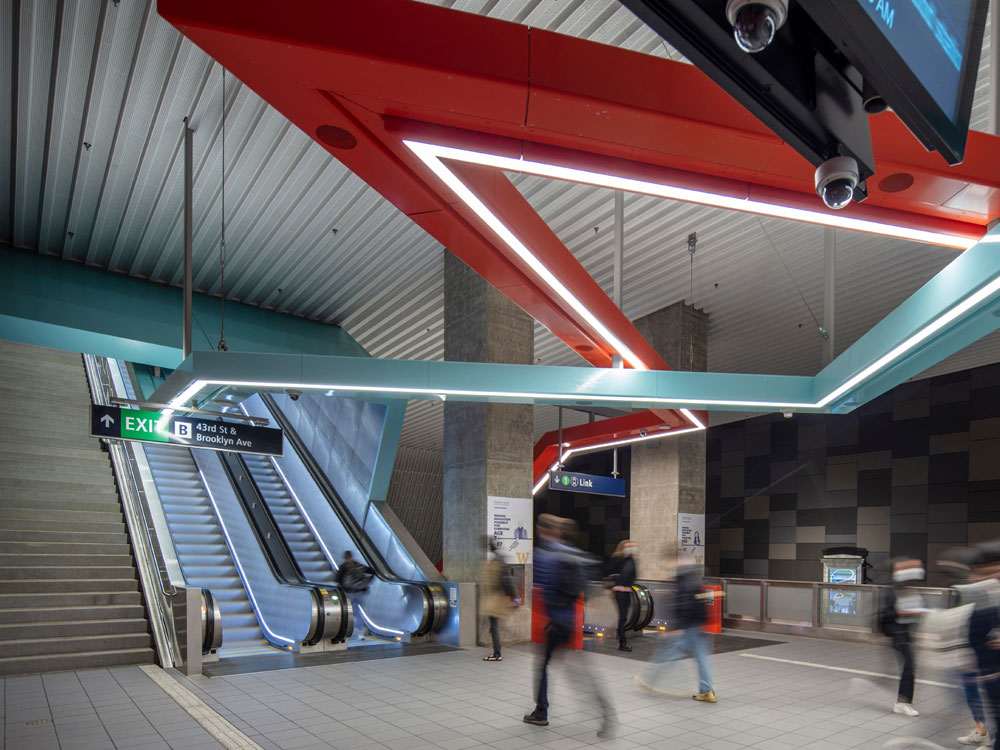
Core Design Team
Firm: LMN Architects
Greg Bishop AIA
Elizabeth Correa AIA
Tiffany Coyne
Aubrey Davidson AIA
Matthew Fisher AIA
Howard Fitzpatrick AIA
Chris Grammens AIA
Mette Greenshields AIA
Kailin Gregga
James Johnson
Eun Jun AIA
Winnie Lam AIA
Maya Leites
Po-Hsuan Li
Jennifer Marckx
Chris Martin
David Matthews AIA
Evan McQuillen
John Mrozek AIA
John Nesholm FAIA
Eric Nothdurft AIA
John Park
John Petterson AIA
Mark Reddington FAIA
Byron Rice AIA
Tyler Schaffer AIA
Todd Schwisow AIA
Martin Sicotte
Kathy Stallings AIA
Sally Tsang
Victor Velarde
Jon Wagner
Jennifer Whitney AIA
John Woloszyn AIA
Consultants/Collaborators
Prime Consultant; Project Manager, Lead Structural & Geotechnical Engineer: McMillen Jacobs Associates
Above Grade Structural Engineer: Bright Engineering
Civil Engineer: KPFF Consulting Engineers
Landscape Architect: Swift Company
Mechanical, Plumbing, and Fire Protection Engineer, Traffic & Lighting Design: WSP
Electrical Engineer: Elcon Associates
Building Management Systems: Triunity, Inc
Communications: LTK
Vertical Transportation and Acoustical Design: The Greenbusch Group, Inc.
Artist: Lead Pencil Studio
Construction Management: NorthSTAR JV
General Contractors: Hoffman Construction Company (GC)
University Mechanical Contractors (MCCM): VECA (ECCM)
Project Narrative
Seattle’s University District is a bustling and eclectic mixed-use community situated directly between the city’s downtown core and the burgeoning neighborhoods to the north. With the University of Washington’s Seattle campus and numerous commercial enterprises creating a destination for thousands of students, workers, and visitors every day, this new station anticipates record numbers of riders in fulfillment of its pivotal role in Seattle’s urban evolution. The new station provides pedestrians, cyclists, bus commuters and residents accessibility to a highly functional, easy-to-use, and appropriately scaled transit hub conveniently located for their diverse activities.
The U District Station is the first stop on the Northgate Link, a 4.3-mile light rail extension from the University of Washington Station on its way north. With the train platform located 85 feet below street level, the bulk of the station’s 105,000-square-foot area is below grade, served by two entrances on Brooklyn Avenue NE between NE 43rd Street and NE 45th Street. The balance of the above-grade site accommodates a future high-rise transit-oriented development project to be constructed on top of the station. Each of the two entries provides elevators, escalators, and stairs to the trains below. The north entrance lobby serves riders heading to and from the adjacent Neptune Theater, nearby UW Tower, and the major Metro bus transfer hub on NE 45th Street. The south lobby gives pedestrians a direct link to the UW campus a few blocks east. Creating a pedestrian-friendly experience, the sidewalks and streets facing the entrances meet Green Street standards, with ample landscaping, pedestrian lighting, seat walls, and a bike lane. For bike commuters, both entrance lobbies offer bicycle storage and racks.
From the north and south lobbies, patrons descend through the escalator and stair tubes to a mid-level open landing, placed within a tall voluminous central space, and continue to the train platform below via open escalators or an open stair. The landing appears to float above the angled cross-bracing elements and is offset to the east. The offset, along with artwork and video installations on the west wall, create a design asymmetry that will help to define north-south wayfinding and directionality on the platform. While passengers wait for their trains, they will experience “Fragment Brooklyn” by Annie Han and Daniel Mihalyo of Lead Pencil Studio. The artwork is a collection of sculptural pieces formed from stainless steel woven wire fabric into architectural appendages containing video screens depicting domestic life.
The large central volume is defined by a white corrugated metal ceiling and canted walls that conceal essential back-of-house functions. Wayfinding is enhanced by ingenious overhead aluminum tubes containing lighting, speakers, and other systems, which begin at the north and south station entries and trace a path to the platform. Two different colors developed in collaboration with the community aid passengers in orienting north and south: orange for north and blue for south.
The station joins a network of vibrant stations with public art and sustainable design that connect to a diversity of neighborhoods in the Seattle Metropolitan area. It contributes another innovative, visionary station to Sound Transit’s growing light rail network.













